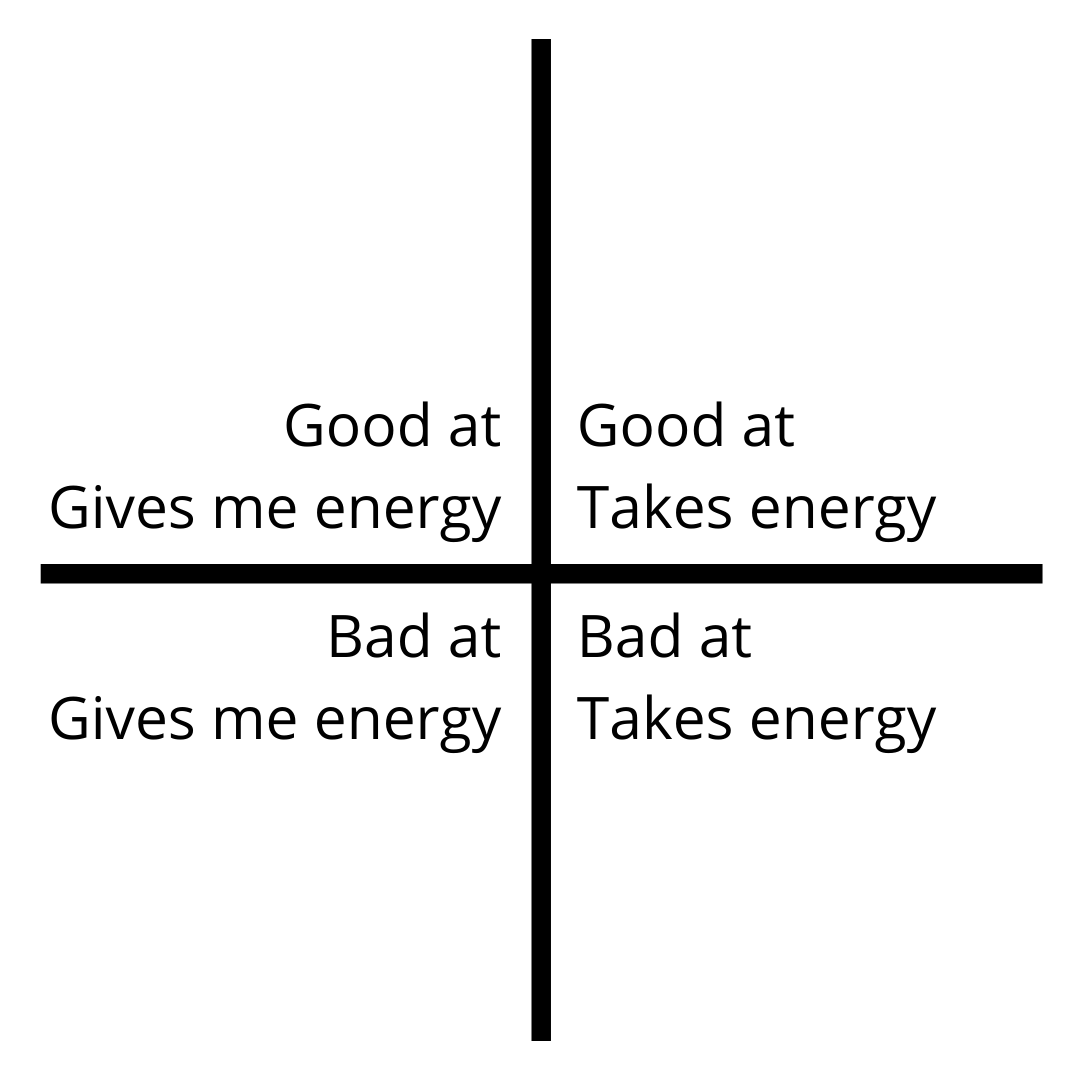Burnout Syndrome is soon to be recognized as a diagnosable phenomenon in the ICD-11 (medical diagnosis). It is commonly defined as a process with four stages: enthusiasm, over-investment, disillusionment, and burnout (Salmenbier-Trichard, 2019). Each stage of the burnout process is characterized by physical, emotional, mental, relational, and organizational features and can be reversed and prevented with habits and practices in each of these categories.
Burnout is a hot topic in startups in part because the “recipe for burnout” includes overcoming challenges in changing environments, unpredictable schedules, physical demands, added responsibility without clear guidance, and interpersonal demands… aka working in a startup. To make the risk of burnout in startups even more clear, the first and second stage are enthusiasm and over-investment—characteristics that are both hired for and cultivated within a startup environment. In fact, startups cannot succeed without people willing to throw their whole selves into work.
However, as employees and founders start to move from stage one (enthusiasm) into over-investment, the gremlins of burnout start to emerge. These might include physical and emotional exhaustion, feelings of cynicism and detachment, a sense of ineffectiveness and lack of accomplishment, insomnia, chronic fatigue, difficulty concentrating, apathy, irritability, anxiety and getting sick, respiratory problems and gastrointestinal issues... Yeah—not good.
We will go through these in more detail in the following sections. You may read through each of these sections and highlight or circle the statements that resonate with you. Although this is not an official quiz or assessment, it will help you locate yourself on this curve and begin to practice habits to prevent or reverse burnout.
Stage 1: Enthusiasm
The first stage of burnout isn’t really a stage at all, it’s a compilation of predisposition and risk factors. Some theories of burnout suggest that idealistic and highly motivated individuals who are dedicated to their work are more likely to burnout (Büssing and May, 1997). Furthermore, workplaces that are uncertain, fast-paced, and demanding work at the edge of each person’s competence also set up an environment in which burnout can grow. However, having the predisposing factors DOES NOT mean that you will develop burnout. You can stay in enthusiasm indefinitely if you care for your physical, mental/emotional and relational wellbeing.
At the end of this section is a reflection to help you design your workload and home activities to be sustainable.
Enthusiasm might look like:
Physical enthusiasm
- Willing to sacrifice sleep to finish work
- Beginning the work day early and ending late
- Working quickly and efficiently as if on a sprint
Emotional/mental enthusiasm
- Thinking and talking about work outside of work hours
- Beginning to take on work problems as personal projects
- Identifying with your role or workplace
Relational/organizational enthusiasm
- Investing heavily in work relationships
- Stepping in to understand and solve interpersonal problems at work
- Significant emotional energy spent comparing yourself to others
- Strategically aligning yourself with key leaders and adopting workplace culture as your own
Suggestion: Try an energy audit
If you identify at this stage, try an energy audit.
An energy audit is an opportunity to explore where you get your energy and what takes away your energy. At work we are often doing things that drain us, and are not the best use of our talents and skills.
Step one of an energy audit is to make a list of tasks and activities in your job. Then score each activity on how much energy it gives you or takes from you. I recommend a -5 to +5 scale. You'll know if the task/activity gives you energy if after you do it or during it you feel energized, inspired, or if you don't want to stop! If after the task/activity you feel drained, depleted or reticent to do it again, it likely drains your energy. Finally, make a determination if it's something you are naturally good at or bad at. Don't get too hung up on how good or how bad or if you can improve at this point.
Step two is to plot your tasks and activities on this chart by what gives you energy and what drains you, and what you are naturally good at and not so good at:

If you are spending a significant amount of your day in activities that drain your energy, you may choose to do an additional activity to examine if any of these can be removed, delegated, or shifted in a way that creates an energy-producing state. If you are spending significant time in the two areas that take energy, you are likely on the path towards burnout.
Stage 2: Over-investment
Just like having your money over-invested, over-investing at work can put you in a precarious position. Over-investment is where the behaviors that lead to burnout start to take hold and become habits. In this phase most of us are starting to feel dissatisfied or recognize that things aren’t working. Many high-achieving people redouble their efforts at work, seeking recognition or trying to justify their lack of balance. This, of course, results in the early stages of Burnout Syndrome. Many of us live here for years and years. The more an over-investor invests in work the less they notice all of the factors missing in their lives. This stage can be characterized as “one-chapter living.” This essentially means that instead of having multiple sections, priorities and areas of interest in your day, you just focus on one: work.
Over-investment might look like:
Physical over-investment
- Tired at the end of work days and non-work days
- Sleeping problems including difficulty falling asleep, staying asleep, or getting too little sleep
- Engaging in escaping behaviors like a “wind-down” drink after work or zoning out to television
- Eating poorly (too much, too little, or the wrong things)
- Totally neglecting exercise or active recreation
Emotional/mental over-investment
- Desire to “check out” or “zone out”
- Lack of desire to engage in non-work activities
- Feeling numb, tired, wired, or jittery when sitting still
- Losing touch with friends, family, and not making time for intimate connections
- Getting a great feeling over being a “hero” at work, balanced with disappointments or imposter feelings
Relational/organizational over-investment
- Irritable with colleagues, friends, and family
- Noticing or actively seeking “role-creep” and taking on more than one person can/should do
- Identity is totally wrapped up in work
- Start reacting to work being thrown at you rather than designing your days and contributions
Suggestion: Try to fill out your wheel of life
If you identify with this stage, try to fill out your wheel of life.
This activity is intended to help you reflect on what's important in your life and how you are attending to all of your values.
Stage 3: Disillusionment
Disillusionment is the third stage of burnout, and the actual symptoms of burnout appear here. Folks often complain of feeling physically uncomfortable; seeing stress manifesting in headaches, stomach aches, and musculoskeletal discomfort. Most of these symptoms are the early warning signs of habits and chronic stress starting to take hold. In the third phase of burnout it is necessary to create space for multi-chapter living and adequate sleep, diet, exercise, and social engagement. Many people benefit from working with an integrative doctor who can test cortisol levels and a therapist or coach who can support healthy habit change.
Disillusionment might look like:
Physical disillusionment
- Headaches
- Gastrointestinal problems
- Sleep issues
- Over reliance on coffee and alcohol (or other drugs) to speed up and slow down
- Weight-loss or weight-gain
- Getting sick more often
Emotional/mental disillusionment
- Fatigued, especially in the afternoons
- Low mood, negative self-talk, and lack of motivation for previously enjoyed activities
- Irritable at work and home, often feeling hurried or anxious
- Loss of optimism or hope, becomes despondent about the outcomes of effort
- Imposter syndrome and doubting one’s abilities
Relational/organizational disillusionment
- Isolation, loneliness, or neglect of significant relationships
- Desire to stop working, maybe increased absenteeism or fantasy of taking days off
- Decreased attention to detail, loss of focus, increased disorganization or confusion
- Intermittent hatred or dislike for work, and disconnection from the mission and vision
Suggestion: Take a burnout assessment
If you feel like you may be in this phase, consider taking a burnout assessment. The Maslach Burnout Inventory is the gold standard for workplace burnout research. You can find this test online, such as here.
Stage 4: Burnout
If you took the burnout assessment, many of the factors of burnout are represented there. By the time people get here, it’s pretty clear what’s going on. Leaders I have known end up in the hospital with stress-related disorders, ongoing sickness, and autoimmune disorders (also related to stress). Others become so numb or anxious that they simply cannot make it into work another day. Burnout is a condition that requires support and space for healing. If you're reading this, you do not have full blown burnout: a) you wouldn't be at work and b) you couldn't concentrate long enough to get through this blog post. This is great news! In every stage prior to this one, burnout is preventable and symptoms are reversible with some self-awareness and intentional practice.
How to minimize the risk of burnout
In much of my research on burnout the organizational factors are cited as the driving force behind the burnout of the individual. These factors are important and they make up a part of what contributes to individual burnout. We all have the opportunity to contribute to workplaces that create clear directives, provide social support, communicate respect and appreciation, and offer as much autonomy as possible in each role. Culture is constructed from the top down and the bottom up in organizations, each person is complicit in a culture in which burnout is allowed and promoted. Here are some things you can do to minimize the risk of burnout at your company.
- Offer team members autonomy in creating their work processes
- Recognize others for their contributions and notice their sacrifices
- Support one another in great self-care by asking about sleep, exercise, diet, social lives, and meditation practice regularly
We are also all responsible for setting up sustainable lives that support our values. There are two pieces to constructing a life resistant to the symptoms of burnout: 1) reflect on your values, and life-giving, and life-sucking activities to create a life design that is energy positive (activity above); 2) develop psychological and physical resilience by attending to each piece of your wheel of life (activity above). Both of these require significant self-reflection and self-knowledge. Knowing yourself, what you need, and your greatest ways to contribute sets you up to be enthusiastic in your work for a long, long time.
